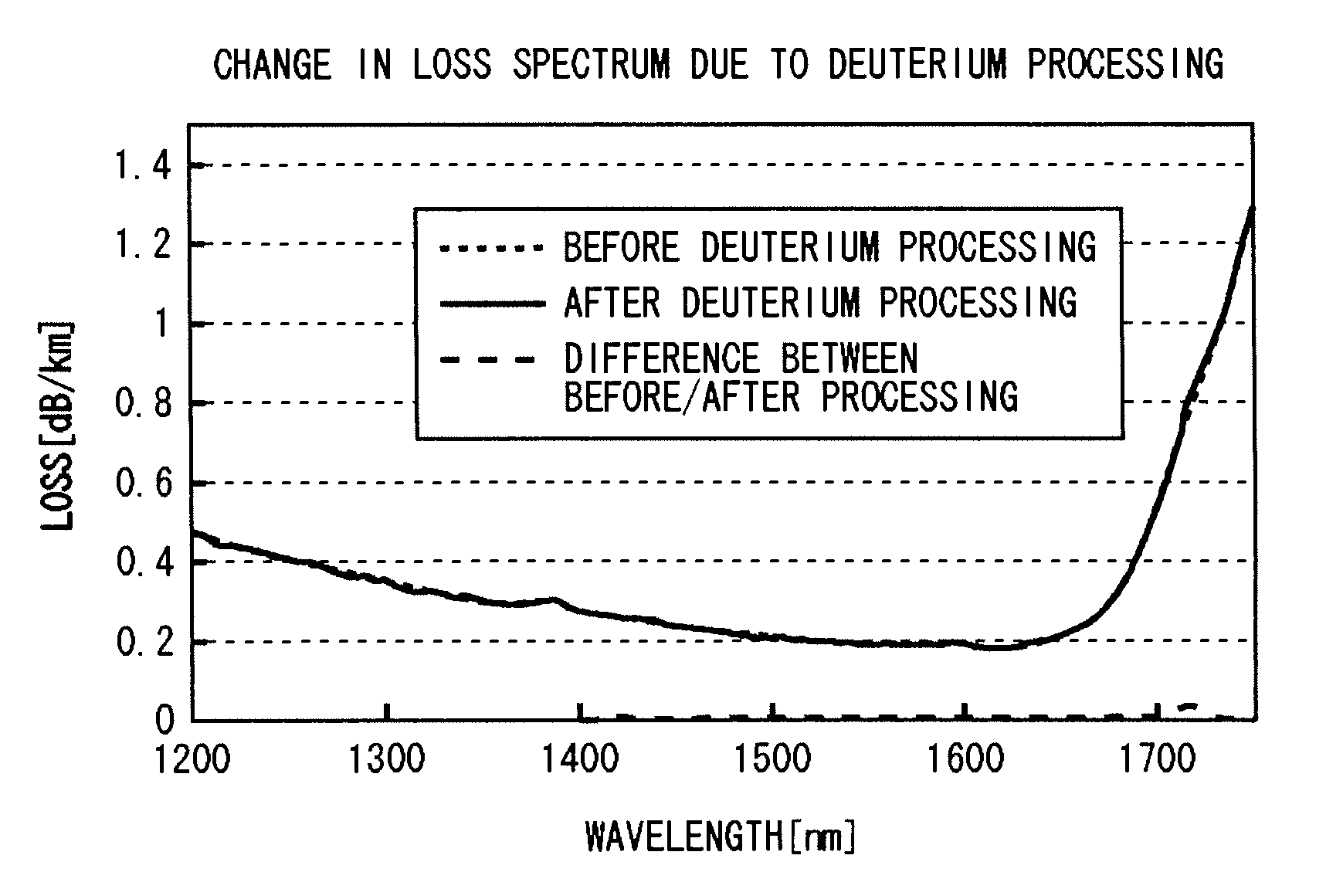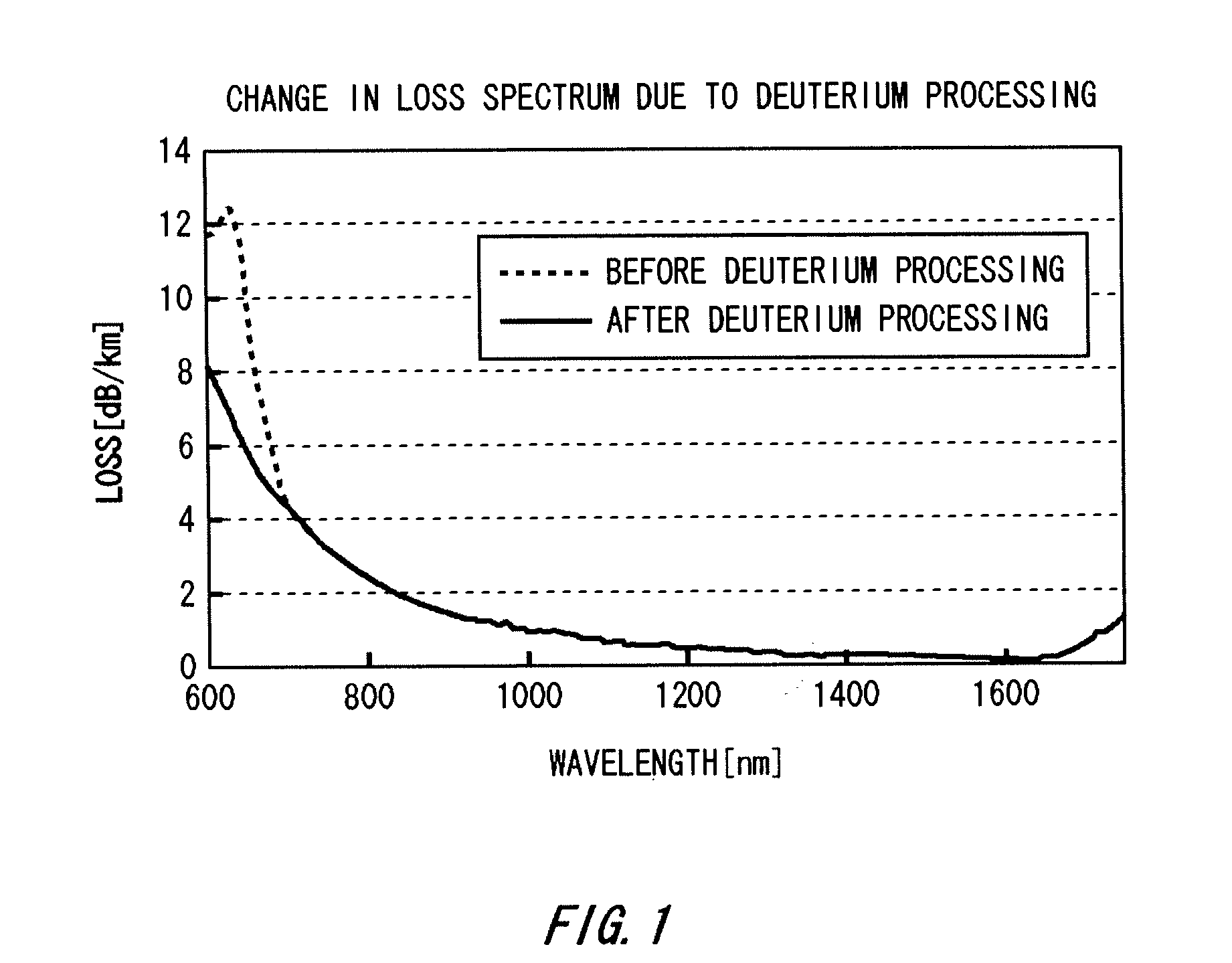Method for treating optical fiber
a processing method and technology for optical fibers, applied in the direction of material analysis using wave/particle radiation, instruments, manufacturing tools, etc., can solve the problems of wasting time and money, unable to evaluate the hydrogen resistance characteristic of optical fibers, and the evaluation method is not suitable as a product evaluation method, etc., to improve the hydrogen resistance characteristic, confirm and improve the effect of deuterium processing
- Summary
- Abstract
- Description
- Claims
- Application Information
AI Technical Summary
Benefits of technology
Problems solved by technology
Method used
Image
Examples
first embodiment example
[0036]An optical fiber having a small WP is manufactured, and a length of 25 km from the optical fiber is wound to a spool as an evaluation sample. In addition, from the same optical fiber, a length of 2 km of a preliminary evaluation sample is cut off, for use in an effect measurement of the deuterium processing detailed later. Furthermore, from the same optical fiber, a length of 2 km of optical fiber is further cut off and stored as a comparison sample.
[0037]Prior to the deuterium processing, the loss spectrum of each of the evaluation sample and the preliminary evaluation sample is measured. At the wavelength of 630 nm, a large absorption loss peak of 6 dB / km is measured for a preliminary evaluation sample having a length of 2 km. In contrast, for an evaluation sample having a length of 25 km, the loss at 630 nm was too large and so the loss per unit length could not be measured. The loss at the wavelength of 1714 nm was measured to be 0.750 dB / km, for both of the evaluation sam...
second embodiment example
[0045]An evaluation sample having a length of 25 km and a preliminary comparison sample having a length of 2 km were prepared. The deuterium processing was conducted thereto under the same condition as in the first embodiment example, except for setting the change quantity of loss at the wavelength of 1714 nm at the time of ending the deuterium processing to be 0.03 dB / km. After the samples were exposed to the deuterium atmosphere for about 4 days, the loss at 1714 nm being the target of monitoring has reached 0.780 dB / km, and the change quantity has exceeded 0.03 dB / km, and so the deuterium processing was ended.
[0046]The loss spectrum was measured for the preliminary evaluation sample having a length of 2 km. The result shows a great loss reduction in the vicinity of the wavelength of 630 nm. In addition, an evaluation test was conducted to the preliminary evaluation sample according to a method prescribed in IEC 60793-2. The result shows no increase in WP. These confirm that an op...
PUM
| Property | Measurement | Unit |
|---|---|---|
| Nanoscale particle size | aaaaa | aaaaa |
| Wavelength | aaaaa | aaaaa |
| Wavelength | aaaaa | aaaaa |
Abstract
Description
Claims
Application Information
 Login to View More
Login to View More - R&D
- Intellectual Property
- Life Sciences
- Materials
- Tech Scout
- Unparalleled Data Quality
- Higher Quality Content
- 60% Fewer Hallucinations
Browse by: Latest US Patents, China's latest patents, Technical Efficacy Thesaurus, Application Domain, Technology Topic, Popular Technical Reports.
© 2025 PatSnap. All rights reserved.Legal|Privacy policy|Modern Slavery Act Transparency Statement|Sitemap|About US| Contact US: help@patsnap.com



